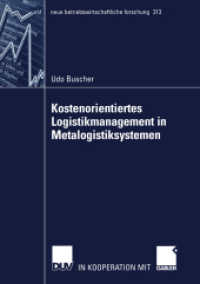Full Description
Epidemiology of Cannabis: Genotoxicity, Neurotoxicity, Epigenomics and Aging provides a novel and comprehensive exploration of five areas that have previously been associated with cannabis use, namely mental health in adults and young adults, pediatric autism, congenital anomalies, cancers, and aging. The book also explores the possibility of how these associations might be reflected in overall disease trends at the population health level. This book surveys these five areas in detail and applies cutting-edge analytical software and geospatial space-time analytical techniques to these questions.
With all this information gathered into one book in an easily readable form, this book is a reference for clinicians, health science and allied health practitioners, public health and basic science researchers and drug and health regulators interested in these topics. It is also suitable for inclusion in course work and study preparation courses at both the undergraduate and postgraduate levels.
Contents
Section A Mental illness
1 Close parallels between cannabis use and deteriorating US Mental Health at four levels supports and extends the epidemiological salience of demonstrated causal mental health relationships: A geospatiotemporal study
Introduction
Methods
- Analysis plan
- Statistical considerations
- Data availability
- Assessing causalityResults
- National level
- Regional level
- State level
- Substate level
- Considerations of causality
- Koch's postulates
- Hills' causal algorithm
- Brain disease pathways and mechanisms
- Cannabis and mass violenceBrain
- Endocannabinoid system in the brain
- Dopamine
- Other
- Mitochondriology
- Immunome
- Genomic studies
- Cannabinoid-opioid interactionsConclusion
Section B Autistic spectrum disorder
2 Linked rise of cannabis use and autism incidence demonstrated by close three-level geospatiotemporal relationships, USA, 1990-2011
Introduction
Methodological comment
- Assessing causality
- Data availabilityResults
- National level data
- Regional level
- State level data
- Impact of cannabis legal status on autism rates
- Causal inferenceDiscussion
- Mechanistic considerations
- European neuroteratology studies
- Morphogen gradients guide brain development
- Retinoic acid
- Slit-Robo
- Neurexin-neuroligin
- DSCAM and DLGAP2
- Oligodendrocytes and myelination
- Genomic studies
- Epigenomic studies
- Pediatric poisoningsConclusion
General questions
Case studies
- Case 1
- Case 2
- Case 3
Section C Congenital anomalies
3 Geospatiotemporal and causal inferential analysis of United States congenital anomalies as a function of multiple cannabinoidand substance-exposures: Phenocopying thalidomide and hundred megabase-scale genotoxicity
Executive summary
- Introduction
- Methods
- Ethics
- Results
- Cannabis-related defects
- Upper quintile threshold discontinuityConclusion
Cannabis-related congenital anomalies
- Cannabis-related anomalies by geotemporospatial criteria, N=38
- Cannabis-related anomalies by prevalence ratio criteria, N=44
- Cannabis-related anomalies by prevalence ratio criteria, N=42Introduction
- Methodology
- Data sources
- Cannabis consumption quintiles
- Data analysis
- Statistics
- Broom-Purrr multimodel assessments
- Matrix multiplication
- Geospatial modeling
- Two phases of data analysis
- Spatial error structures
- Spatial model specification
- Corrections for multiple testing
- Assessing causality
- Data availability
- EthicsResults
- Section one: Drug use by ethnicity and age
- Section two: Drugs and congenital anomalies overview
- Section three: Chromosomal defects
- Section four: Gastroschisis and body wall
- Section five: Atrial septal defect (secundum type)
- Section six: Cardiovascular defects of interest
- Section seven: Hawaiian—American reviewDiscussion
- General considerations
- Bivariate analysisSummary observations
- Data summary
- Forest plot
- Canada
- Australia
- Mechanistic summary
- Multivariable analysis
- Multivariable causal analysis
- Multivariable causal analysis
- Effect of cannabis legalization
- Considerations of causality
- Geotemporal trimodality
- Causality and the hill criteria
- Causal inference
- Causal assignment
- CommonalityPathways and mechanisms
- Genotoxic mechanisms
- Morphogen gradients control body formation and patterning
- Cannabinoid modulation of other morphogenetic pathwaysSpecific organ systems
- Heart
- Respiratory defects
- Face
- Gastrointestinal tract
- Urinary tract
- Body wall anomalies
- Limbs
- Chromosomal defectsInteractions of other major morphogen systems with cannabinoids
- Cannabinoid teratology
- Chromosomal mechanics and dynamics
- Sperm and cannabinoids
- Oocytes and cannabinoids
- Embryonic developmentConclusion
- Directions for future researchCongenital anomalies general questions and case studies
- General questions
- Case studies
-- Case 1: Jodie
-- Case 2: Jennifer
Section D Cancer and Heritable Cancer
4 Geospatiotemporal and causal inferential epidemiological survey and exploration of cannabinoidand substance-related carcinogenesis in the United States from 2003 to 2017 (Online chapter)
Section E Epigenetics and aging
5 Multivalent cannabinoid epigenotoxicities and multigenerational aging
Introduction
Definitions
Epigenetic layers
Hallmarks of aging
Methodology
- Data
- Computations
- Ethical permissionResults and discussion
- Historical studies
- Mitochondrial inhibition
- Important earlier epigenomic studies
- Longitudinal human sperm study
- Detailed analysis of longitudinal sperm study results
- Perturbation of fundamental epigenomic machinery
- Stem cell genes
- Age-related immunometabolic genes
- Chromosomes, centrosomes, and kinetochores
- DNA repair
- EpigenomicsEpigenomics of cannabinoid teratology
- Brain
- Cannabinoid neurotoxicity
- Cannabinoid epigenomic neurotoxicity
- Summary of cannabinoid neurotoxicity
- Cardiovascular system
- Other organs and systems
- Chromosomal anomalies
- Uronephrology
- Body wall
- Teratological summaryEpigenomics of cannabinoid-related cancers
Epigenomics of aging
- Overview of conceptual aging paradigm
- Aging is driven by a loss of epigenetic information
- Epigenomics
- Overall pattern of cannabis toxicity
- Hallmarks of cannabinoid accelerated agingEpigenomic—genomic overlap in aging syndromes
- Heterochronic parabiosis
- Haemopoietic stem cells
- Heterochronic CSF circulation
- Movement in fibroblasts
- Ovarian aging
- Mouse agingEpigenomics and pathobiology of aging
- Inflammation and stem cells
- Cardiovascular disease
- Hematopoietic stem cells
- Skeletal muscle
- Summary genomic-epigenomic tables
- Summary of cannabinoid aging accelerationOverall summary of multivalent cannabinoid epigenotoxicities
Case studies—Epigenetics and aging
- Leonard - Case description
- Case questions
- Q multiple choice
6 Conclusion








